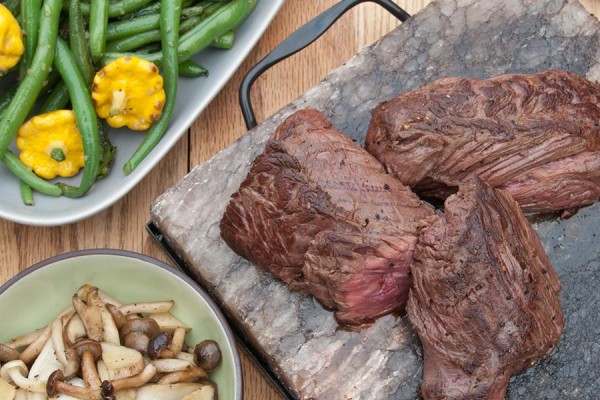Himalayan Salt Block Cooking
There’s a good chance you haven’t heard of the latest craze in the otherwise unremarkable household item we refer to as “salt.” It’s not the pile of ground crystalline food seasoning you’d normally think of – this is an unrefined, thick slab of mineral goodness straight from the earth called Himalayan salt. Instead of just sprinkling it over your food, it can actually be used to cook it! To give you a better picture, here’s… well… a picture!
Since there aren’t many resources on salt blocks, we thought we’d give you a full tour of one of our favorite new kitchen tools.
Himalayan Salt Block Basics
Let’s talk about the basics of these Himalayan salt blocks for a moment. As the name implies, the blocks originate from the Himalayan Mountains. Although the Himalayas are most closely associated with the country of Nepal, the range stretches from Bhutan to Nepal, and then across the northern borders of India and Pakistan. Most salt blocks are mined from these regions in Pakistan. Blocks mined from the earth are at least 500 million years old!
Salt blocks have an amazing capacity to retain thermal energy; when they get hot they’re able to stay hot for quite some time, even after being removed from flame. According to author Mark Bitterman in his book Salt Block Cooking, they’re capable of reaching temperatures from -321° F. to 1473° F. Salt blocks can be used in the oven, on the stove, or even in your backyard grill to cook a variety of proteins and vegetables. They can even be used as a serving plate for cold dishes.
Won’t my food be really salty if I use a salt block?
Not necessarily! In general, Himalayan salt has a more mild salt flavor than table salt or sea salt. There are also a few variables that control how much salt flavor your food will pick up. These general guidelines are:
- The more time your food spends on the block, the saltier it will be.
- If you brush ingredients with oil or fat before cooking, they’ll tend to be less salty when finished.
- How much surface area of the food actually comes into contact with the salt block.
- Foods with higher moisture content will pick up more saltiness.
- The hotter your block is when you cook, the less salty your food will be.
Other Uses for Salt Blocks
Salt blocks can also be used a few other ways aside from on the stove, grill, or in the oven. Preheated salt blocks can be set on top of large roasts to provide heat from both directions and decrease cooking time. Salt blocks also make wonderful serving vessels for appetizers or desserts, not only for their ability to impart salt, but also because of their visual appeal. Salt blocks also make great tools for curing meats.
Himalayan Salt Block Care
If you’ve purchased a salt block, you’ll want to pay strict attention to how you care for it. Properly caring for your block will help to extend its useful life. Here are a few tips:
- Preheat your salt block slowly and in stages; this will help to avoid breaking the block due to thermal shock. Start with the burner on low, preheat for 15 minutes, then increase to medium and preheat another 15 minutes. If high heat is needed, repeat the process one more time with another 15 minutes preheating on high flame.
- Use a damp sponge to clean your Himalayan salt block. Do not use soap. Salt blocks are naturally sterile due to their mineral makeup so soap isn’t necessary.
- Avoid dropping your salt block as they are heavy and may break if dropped. A good way to get a better grip on your salt block is to purchase a salt plate holder and carrying case.
- Store your block in a cool, dry place. Salt blocks are hydroscopic, meaning they draw moisture from their environments, which can accelerate the rate at which they dissolve.
If you haven’t purchased a salt plate, what are you waiting for? The Himalayan salt block is a great way to cook your favorite foods in a new, eye-appealing way. From start to finish, these plates have a wide variety of uses for an amazing array of foods.
Want to know more? Keep your eyes peeled for our Salt Block Cookbook coming out at the end of the year. You can also pick up one of our Himalayan Salt Blocks at select kitchen retailers nationwide.







No comments yet.